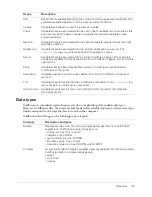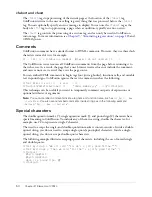
40
Chapter 2: Elements of CFML
Introduction
This chapter introduces and describes the basic elements of CFML. These elements make CFML
a powerful tool for developing interactive web applications. Because CFML is a dynamic
application development tool, it has many of the features of a programming language, including
the following:
•
Functions
•
Expressions
•
Variables and constants
•
Flow-control constructs such as if-then and loops
CFML also has a “language within a language”, CFScript, which enables you to use a syntax
similar to JavaScript for many operations.
This chapter introduces these elements and other basic CFML entities such as data types,
comments, escape characters, and reserved words.
The remainder of Part I of this book provides more detailed information on many of the basic
CFML elements. The rest of this book helps you use these elements effectively in your
applications.
Character case
The ColdFusion server is case-insensitive. For example, the following all represent the
cfset
tag:
cfset
,
CFSET
,
CFSet
, and even
cfsEt.
However, you should get in the habit of consistently using
the same case rules in your programs; for example:
•
Develop consistent rules for case use, and stick to them. If you use lowercase characters for
some tag names, use them for all tag names.
•
Always use the same case for a variable. For example, do not use both myvariable and
MyVariable to represent the same variable on a page.
If you follow these rules, you will prevent errors on application pages where you use both CFML
and case-sensitive languages, such as JavaScript.
Tags
ColdFusion
tags
tell the ColdFusion server that it must process information. The ColdFusion
server only processes tag contents; it returns text outside of ColdFusion to the web server
unchanged. ColdFusion MX provides a wide variety of built-in tags and lets you create custom
tags.
Tag syntax
ColdFusion tags have the same format as HTML tags. They are enclosed in angle brackets (< and
>) and can have zero or more named attributes. Many ColdFusion tags have bodies; that is, they
have beginning and end tags with text to be processed between them. For example:
<cfoutput>
Hello #YourName#! <br>
</cfoutput>
Содержание ColdFusion MX
Страница 1: ...Developing ColdFusion MX Applications...
Страница 22: ...22 Contents...
Страница 38: ......
Страница 52: ...52 Chapter 2 Elements of CFML...
Страница 162: ......
Страница 218: ...218 Chapter 10 Writing and Calling User Defined Functions...
Страница 250: ...250 Chapter 11 Building and Using ColdFusion Components...
Страница 264: ...264 Chapter 12 Building Custom CFXAPI Tags...
Страница 266: ......
Страница 314: ...314 Chapter 14 Handling Errors...
Страница 344: ...344 Chapter 15 Using Persistent Data and Locking...
Страница 349: ...About user security 349...
Страница 357: ...Security scenarios 357...
Страница 370: ...370 Chapter 16 Securing Applications...
Страница 388: ...388 Chapter 17 Developing Globalized Applications...
Страница 408: ...408 Chapter 18 Debugging and Troubleshooting Applications...
Страница 410: ......
Страница 426: ...426 Chapter 19 Introduction to Databases and SQL...
Страница 476: ...476 Chapter 22 Using Query of Queries...
Страница 534: ...534 Chapter 24 Building a Search Interface...
Страница 556: ...556 Chapter 25 Using Verity Search Expressions...
Страница 558: ......
Страница 582: ...582 Chapter 26 Retrieving and Formatting Data...
Страница 668: ......
Страница 734: ...734 Chapter 32 Using Web Services...
Страница 760: ...760 Chapter 33 Integrating J2EE and Java Elements in CFML Applications...
Страница 786: ...786 Chapter 34 Integrating COM and CORBA Objects in CFML Applications...
Страница 788: ......
Страница 806: ...806 Chapter 35 Sending and Receiving E Mail...
















































